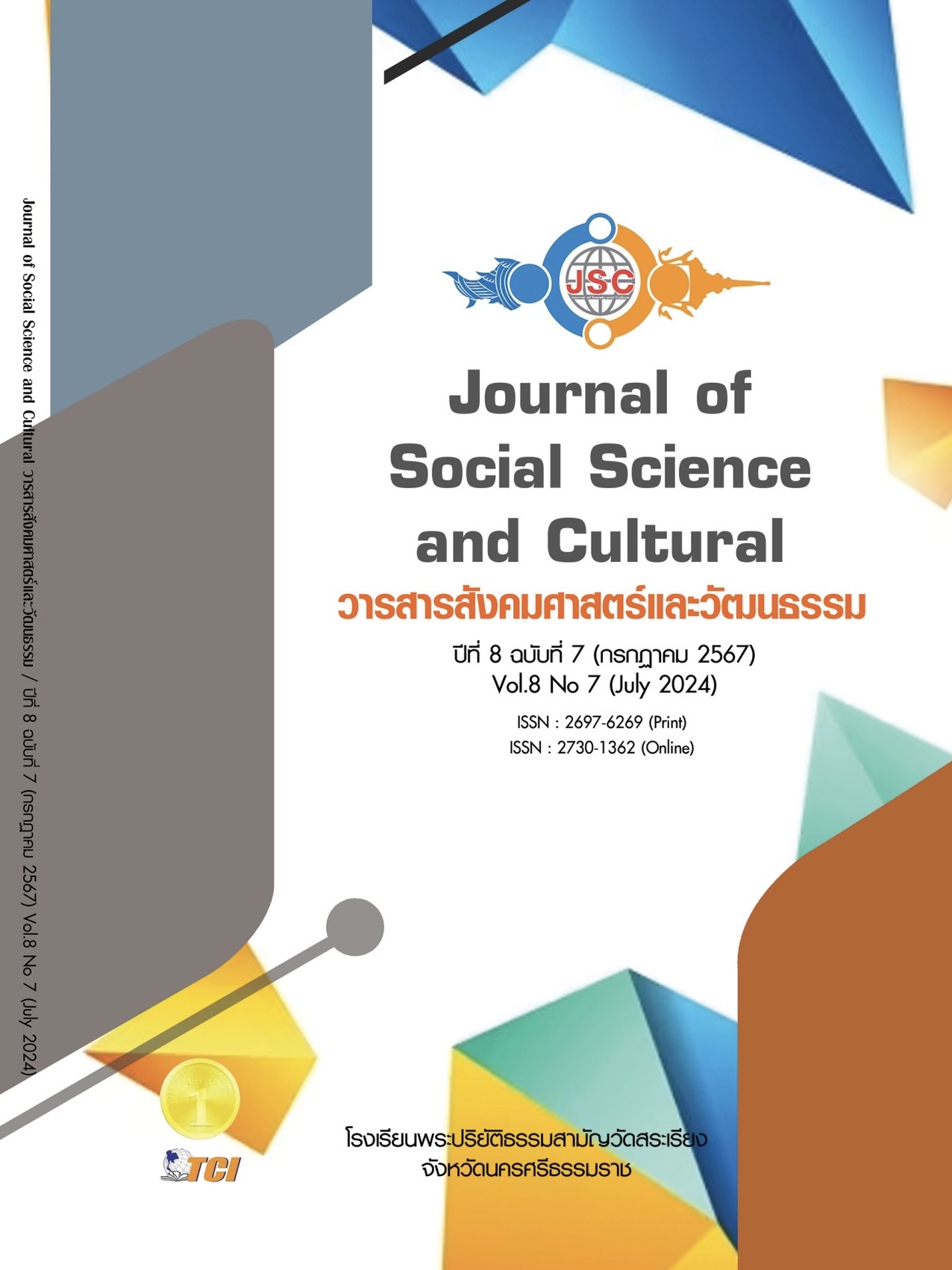MEANINGS OF THE NAMES OF KOREAN RESTAURANTS IN CHON BURI
Main Article Content
Abstract
This research article aims to study the meanings of the names of Korean restaurants in Chonburi Province. It is an exploratory study. The sample group consists of 150 names of Korean restaurants that appear on the main page of the restaurant's page. The sample was purposively selected. Each restaurant name was segmented into lexical units, and the meaning of each name in each of these units was analyzed. Data were collected from the google.com website. The statistics used in the research include frequency and percentage. The research findings reveal that the meanings of the names of Korean restaurants in Chonburi Province can be categorized into 17 groups, listed in order from most to least frequent: 1) food and food ingredients, 2) location, 3) nationality of the food, 4) cooking method, 5) positive feelings, 6) persons, 7) consumption style, 8) invitation, greeting, and hospitality, 9) kinship, 10) nature, 11) behavior, 12) multiple meanings, 13) Korean royalty, 14) numbers related to the restaurant's history, 15) Korean entertainment media, 16) animals, and 17) specific meanings. Most Korean restaurant names refer to food and ingredients, including food types, meat, and seasonings. They also refer to locations, including features of the restaurant, its location, places in the Republic of Korea, and other places, as well as the nationality of Korean food. Interestingly, the meanings of most restaurant names express Korean identity both directly and indirectly. They incorporate the unique aspects of Korean food, places, entertainment media, royalty, and language into the names, reflecting the influence of Korean soft power on the thoughts, feelings, and language preferences of entrepreneurs in Chonburi Province, a culturally diverse area.
Article Details
References
นันทพงศ์ พันธ์ทวีศักดิ์. (2567). ธุรกิจร้านอาหารในจังหวัดท่องเที่ยวภาคตะวันออก (ชลบุรี, ระยอง). เรียกใช้เมื่อ 24 กรกฎาคม 2567 จาก https://www.lhbank.co.th/getattachment/78a56560-613a-4641-8534-6687bed8b280/economic-analysis-Industry-Outlook-2024-SME-Restaurant-Chonburi-Rayong
นันทิพา บุษปวรรธนะ และนาวิน วงศ์สมบุญ. (2563). ความสำเร็จในการเผยแพร่กระแสวัฒนธรรมเกาหลี (Korean Wave): บทบาทของรัฐบาลและอุตสาหกรรมสื่อบันเทิง. วารสารราชภัฏสุราษฎร์ธานี, 7(2), 1-25.
ปดิวลดา บวรศักดิ์. (2567). “ไก่ทอดเกาหลี” จากเมนูในสงครามเกาหลี สู่อาหารยอดฮิตทั่วโลก!!! เรียกใช้เมื่อ 18 กุมภาพันธ์ 2567 จาก https://www.silpamag.com/history/article_102989
ปิติ ศรีแสงนาม. (2561). บทเรียนจากความสำเร็จของกระแสนิยมวัฒนธรรมเกาหลี. เรียกใช้เมื่อ 22 พฤษภาคม 2567 จาก https://www.chula.ac.th/cuinside/6930/
วิสาขา เทียมลม. (2565). อาหารเกาหลีทำให้เราเพลิดเพลิน: อุตสาหกรรมวัฒนธรรมในซีรีส์เกาหลี. วารสารรามคำแหง ฉบับรัฐประศาสนศาสตร์, 5(2), 1-33.
ศิริรัตน์ ณ ระนอง และคณะ. (2565). การวิเคราะห์ภาษาและความหมายของชื่อร้านกาแฟในจังหวัดอุบลราชธานี: การปนของภาษาและความหมาย. ใน การประชุมวิชาการระดับชาติ ครั้งที่ 14 มหาวิทยาลัยราชภัฏนครปฐม. มหาวิทยาลัยราชภัฏนครปฐม.
ศุภิสรา สุขเกษม. (2566). นโยบายส่งเสริม Soft Power ของเกาหลีใต้. เรียกใช้เมื่อ 17 มีนาคม 2567 จาก https://www.ditp.go.th/post/126705
สมชาย สำเนียงงาม. (2562). ป้ายชื่อร้านอาหารไทยในกรุงโซล: การนำเสนอภาษาและวัฒนธรรมไทย. ใน ภาษาสรร วรรณกรรมสาร: เนื่องในวาระ 50 ปี ภาควิชาภาษาไทย คณะอักษรศาสตร์ มหาวิทยาลัยศิลปากร. ภาควิชาภาษาไทย คณะอักษรศาสตร์ มหาวิทยาลัยศิลปากร.
สำนักงานสถิติแห่งชาติ กระทรวงดิจิทัลเพื่อเศรษฐกิจและสังคม. (2566). เขตเศรษฐกิจพิเศษประเทศไทย พ.ศ. 2566. กรุงเทพมหานคร: กองสถิติพยากรณ์ สำนักงานสถิติแห่งชาติ.
JINMING WANG และลภัสรินทร์ ฉัตรวังคีรี. (2565). การศึกษาเปรียบเทียบการตั้งชื่อร้านอาหารในเขตอำเภอเมือง จังหวัดเชียงใหม่ และเมืองฝูโจว ประเทศจีน. วารสารสังคมศาสตร์และมานุษยวิทยาเชิงพุทธ, 7(1), 225-239.


